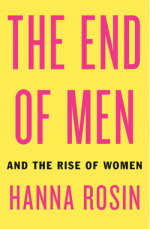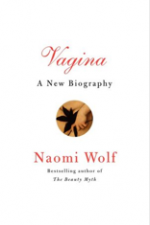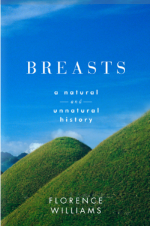TW Opinion by Lorraine Berry and Martha Nichols
Why We Aren’t Grateful—Yet
Last Sunday’s edition of the New York Times Book Review featured an enormous red high heel stomping a tiny man’s oxford, all against a hot-pink background. In case the symbolism wasn’t clear enough, the reviews that appeared on the cover were of two big books by women authors.
 Surely one of them deserved the cover to itself, but the Times ran them side by side, making certain we noticed that the topic is W-O-M-A-N.
Surely one of them deserved the cover to itself, but the Times ran them side by side, making certain we noticed that the topic is W-O-M-A-N.
“Since this week’s issue assesses an array of feminist ideas and arguments,” the editors write of that garishly domineering shoe, “it made particular sense to commission illustrations from a woman.”
In other words, hire a girl to draw the pictures because it’s all girl stuff.
If only the NYTBR could have summoned a political argument about why women’s issues matter to everyone. Instead, it lumped these “feminist ideas”—from Hanna Rosin’s claims about The End of Men to Naomi Wolf’s travails with her Vagina to the environmental alarms raised by Rachel Carson and Florence Williams—into a single edition with the headline “A Woman’s Place.”
The result is depressing, silly, even righteously enraging, considering how much this editorial decision undercuts the many terrific reviews involved. The issue itself could have been dubbed “all that women’s stuff we rarely cover” or “icky stuff we’re being forced to review.” It’s ironic, but not in a good way.
Exhibit A: Jennifer Homans’s sharp critique of The End of Men: And the Rise of Women. Homans, a historian and dance critic at the New Republic, tears apart Rosin’s contention that the service economy, which employs many more women than men, has led to the feminist revolution of our dreams. This review underscores that the continuing lack of gender equality in pay and political power around the world can’t just be shrugged off when it doesn’t match an author’s “sound bite” vision.
Feminists used to care about class analysis, but for Rosin, observing her daughter’s patience (good for sitting still in a cubicle) and her son’s restlessness (bad for working at, say, a call center) is apparently enough to convince her of the eventual triumph of women.
What might have been headlined “The End of Feminism” is a big, meaty subject that involves the global economy and every person, male or female, on the planet. Yet, how does the NYTBR choose to present it? With a scarlet high heel.
 Exhibit B: Toni Bentley’s riotous riff on another tendentious piece of feminist pseudo-scholarship: Naomi Wolf’s Vagina: A New Biography. Bentley (whose 2004 erotic memoir The Surrender makes the Fifty Shades of Grey books look amateurish) lays waste to Wolf:
Exhibit B: Toni Bentley’s riotous riff on another tendentious piece of feminist pseudo-scholarship: Naomi Wolf’s Vagina: A New Biography. Bentley (whose 2004 erotic memoir The Surrender makes the Fifty Shades of Grey books look amateurish) lays waste to Wolf:
Sit back and relax, will you? Naomi Wolf has got her orgasm back. Yep. I know you were worried. We were all worried. I mean, to lose one’s orgasm at a time like this, what with Syria undergoing mass civilian murder and Romney closing in on Obama, it is really enough to put a liberated gal’s thong in a knot.
Bentley’s review alone is worth the price of admission, but running these two very different essays on the cover under the joint title of “A Woman’s Place” makes all too clear that women writers still need to shake a lot of booty to get anyone’s attention. With this kind of spin, feminist critics are in the equivalent of Rosin’s service economy: We get all these column inches, but we don’t yet control how our arguments are presented.
For instance, while Bentley takes apart Wolf’s approach (“calling a book about the female sex ‘Vagina’ is like calling a book about the male sex ‘Scrotum’”), she also emphasizes the importance of Wolf’s topic. Given the “epidemic of unhappy, disrespected female sexuality,” Bentley writes, “[o]ur rage, and Wolf’s, is beyond justified: it is imperative.”
Yet, somehow, the cute pink-and-orange illustration of a woman’s hips with a big white star over the private parts (tee hee!) doesn’t convey rage.
Wolf is a well-known feminist journalist who has written big books in the past, including The Beauty Myth. Rosin’s argument about women’s dominance over men has been a running theme in her articles in the Atlantic, where she’s a senior editor, for more than a year. But if two “important” books about men by male journalists came out in the same week—one an economic argument, the other about prostate cancer—it’s hard to imagine the Times editors slapping them together like giggly BFFs.
Exhibit C: The excellent review by M.G. Lord of Breasts: A Natural and Unnatural History. Florence Williams’s book “is less a primer on anatomy than a catalog of environmental disasters akin to Rachel Carson’s 1962 classic Silent Spring,” Lord writes. The review and book are a call to arms, arguing that women’s breasts have become repositories of vast amounts of chemicals from environmental pollutants.
 It’s not just girl stuff. Indeed, Williams reports much higher than average incidences of male breast cancer in areas with contaminated water—for example, among “badass” Marines at Camp Lejeune. Seems like something of interest to men.
It’s not just girl stuff. Indeed, Williams reports much higher than average incidences of male breast cancer in areas with contaminated water—for example, among “badass” Marines at Camp Lejeune. Seems like something of interest to men.
Yet, the NYTBR relegates the scary, serious vibe to its back pages, sticking the piece about Breasts beside a review of a new Rachel Carson biography.
It’s as if the editors were afraid readers would miss the point: Women. Closer to nature. Earth. Nature. Woman equals Earth. Woman equals T & A.
Such lazy connections imply that only women care about these subjects. In fact, one wonders if men read this edition of the Review at all (aside from Bentley’s sexy and sardonic piece), given that the cover looks as if it were something you’d find at the end of a grocery aisle with the other women’s magazines. It’s not the NYTBR’s fault that Vagina or Breasts are now considered fit titles by “serious” publishers. But couldn’t somebody mention that women are more than the sum of their parts?
Those brightly colored illustrations for the cover essays are by Kelly Blair, a senior designer at Knopf and former Little, Brown art director. In their “Up Front” note, the editors quote Blair as saying she thinks “men and women are represented fairly equally in the publishing world.” But even she adds that “there’s room for improvement.”
Meanwhile, Rachel Carson, whom many deem an environmental hero for her groundbreaking work on the dangers of pesticides, doesn’t get the hip designer treatment. The review of the biography On a Farther Shore is accompanied by a black-and-white photo of Carson in cat’s-eye glasses. No sex there. She’s like an afterthought, as if the editors needed another woman to fill out the issue.
It’s exhausting, keeping count of how many books by women get reviewed in the mainstream press compared with books by men. Or how many female reviewers usually appear in the NYTBR or the New York Review of Books. Journals like the Women’s Review of Books have been keeping track for decades—and just when it seems the trend is better, we end up with the dubious payoff of “A Woman’s Place.”
Gauntlet thrown—again.
Publishing Information
- "A Woman's Place"—Hanna Rosin's The End of Men: And the Rise of Women, review by Jennifer Homans, New York Times Book Review, September 16, 2012.
- "A Woman's Place"—Naomi Wolf's Vagina: A New Biography, review by Toni Bentley, New York Times Book Review, September 16, 2012.
- "Unnatural Women"—Florence Williams's Breasts: A Natural and Unnatural History, review by M.G. Lord, New York Times Book Review, September 16, 2012.
- "The Poisoned Earth"—William Souder's On a Farther Shore: The Life and Legacy of Rachel Carson, review by Elizabeth Royte, New York Times Book Review, September 16, 2012.
 Lorraine Berry is an associate editor at Talking Writing. In TW's September/October 2012 issue about writerly sins, she takes on lust, recounting her time as "Enya Bouche," erotica author for hire.
Lorraine Berry is an associate editor at Talking Writing. In TW's September/October 2012 issue about writerly sins, she takes on lust, recounting her time as "Enya Bouche," erotica author for hire."I threw myself into the writing. As Enya, I felt myself growing to fill the space she was creating. A young man in love with an older woman's body? I could do that." — "Lust: The Literary Courtesan"
 Martha Nichols is editor in chief of Talking Writing. She's also a longtime contributing editor at the Women's Review of Books.
Martha Nichols is editor in chief of Talking Writing. She's also a longtime contributing editor at the Women's Review of Books.
"If human beings were perfect, there would be no stories. Most narratives derive their tension from somebody making bad decisions or ending up in a scary place. But how can you overcome something if there’s nothing to overcome?" — "The Devil Made Me Write It"
